Note
Access to this page requires authorization. You can try signing in or changing directories.
Access to this page requires authorization. You can try changing directories.
Applies to:
SQL Server
SSIS Integration Runtime in Azure Data Factory
Create a SQL Server Integration Services (SSIS) package to load data into SQL Server or Azure SQL Database. You can optionally restructure, transform, and cleanse the data as it passes through the SSIS data flow.
This article shows you how to do the following things:
- Create a new Integration Services project in Visual Studio.
- Design an SSIS package that loads data from the source into the destination.
- Run the SSIS package to load the data.
Basic concepts
The package is the basic unit of work in SSIS. Related packages are grouped in projects. You create projects and design packages in Visual Studio with SQL Server Data Tools. The design process is a visual process in which you drag and drop components from the Toolbox to the design surface, connect them, and set their properties. After you finish your package, you can run it, and you can optionally deploy it to SQL Server or SQL Database for comprehensive management, monitoring, and security.
A detailed introduction to SSIS is beyond the scope of this article. To learn more, see the following articles:
About the solution
The solution is a typical package which uses a Data Flow task that contains a source and a destination. This approach supports a wide range of data sources, including SQL Server and Azure SQL Database.
This tutorial uses SQL Server as the data source. SQL Server runs on premises or on an Azure virtual machine.
To connect to SQL Server and to SQL Database, you can use an ADO.NET connection manager and source and destination, or an OLE DB connection manager and source and destination. This tutorial uses ADO.NET because it has the fewest configuration options. OLE DB might provide slightly better performance than ADO.NET.
As a shortcut, you can use the SQL Server Import and Export Wizard to create the basic package. Then, save the package, and open it in Visual Studio or SSDT to view and customize it. For more info, see Import and Export Data with the SQL Server Import and Export Wizard.
Prerequisites
To step through this tutorial, you need the following things:
SQL Server Integration Services (SSIS). SSIS is a component of SQL Server and requires a licensed version, or the developer or evaluation version, of SQL Server. To get an evaluation version of SQL Server, see Evaluate SQL Server.
Visual Studio (optional). To get the free Visual Studio Community Edition, see Visual Studio Community. If you don't want to install Visual Studio, you can install SQL Server Data Tools (SSDT) only. SSDT installs a version of Visual Studio with limited functionality.
SQL Server Data Tools for Visual Studio (SSDT). To get SQL Server Data Tools for Visual Studio, see Download SQL Server Data Tools (SSDT).
This tutorial connects to a SQL Server or a SQL Database instance and loads data into it. You have to have permission to connect, to create a table, and to load data on one of the following destinations:
An Azure SQL Database database. For more info, see Azure SQL Database.
or
A SQL Server instance. SQL Server runs on premises or on an Azure virtual machine. To download a free evaluation or developer edition of SQL Server, see SQL Server downloads.
Sample data. This tutorial uses sample data stored in SQL Server in the AdventureWorks sample database as the source data. To get the AdventureWorks sample database, see AdventureWorks Sample Databases.
A firewall rule if you're loading data into SQL Database. You have to create a firewall rule on SQL Database with the IP address of your local computer before you can upload data to the SQL Database.
Create a new Integration Services project
Launch Visual Studio.
On the File menu, select New > Project.
Navigate to the Installed > Templates > Business Intelligence > Integration Services project types.
Select Integration Services Project. Provide values for Name and Location, and then select OK.
Visual Studio opens and creates a new Integration Services (SSIS) project. Then Visual Studio opens the designer for the single new SSIS package (Package.dtsx) in the project. You see the following screen areas:
On the left, the Toolbox of SSIS components.
In the middle, the design surface, with multiple tabs. You typically use at least the Control Flow and the Data Flow tabs.
On the right, the Solution Explorer and the Properties panes.
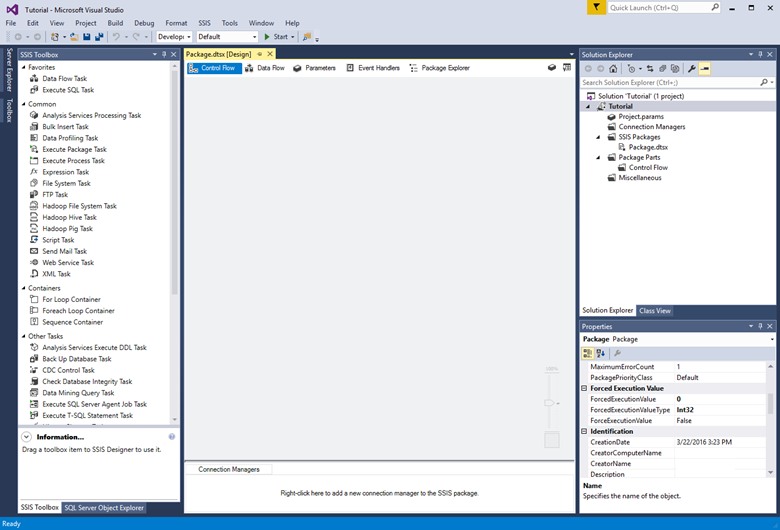
Create the basic data flow
Drag a Data Flow Task from the Toolbox to the center of the design surface (on the Control Flow tab).
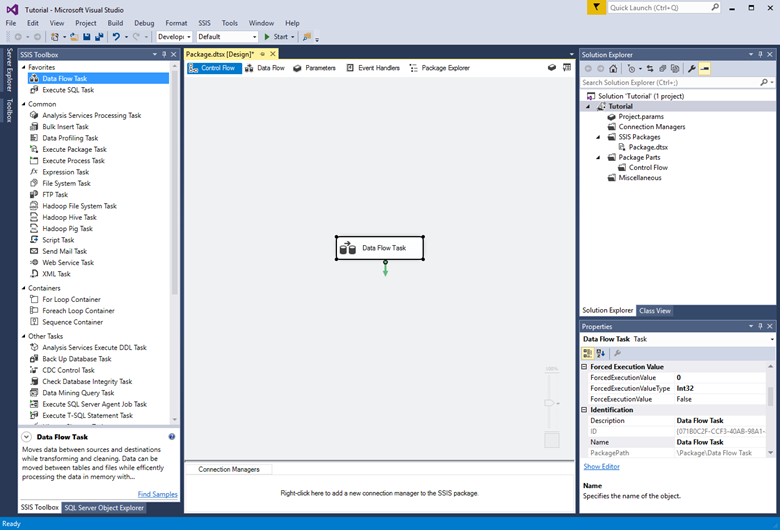
Double-click the Data Flow Task to switch to the Data Flow tab.
From the Other Sources list in the Toolbox, drag an ADO.NET Source to the design surface. With the source adapter still selected, change its name to SQL Server source in the Properties pane.
From the Other Destinations list in the Toolbox, drag an ADO.NET Destination to the design surface under the ADO.NET Source. With the destination adapter still selected, change its name to SQL destination in the Properties pane.
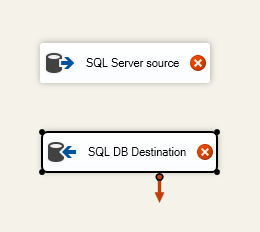
Configure the source adapter
Double-click the source adapter to open the ADO.NET Source Editor.
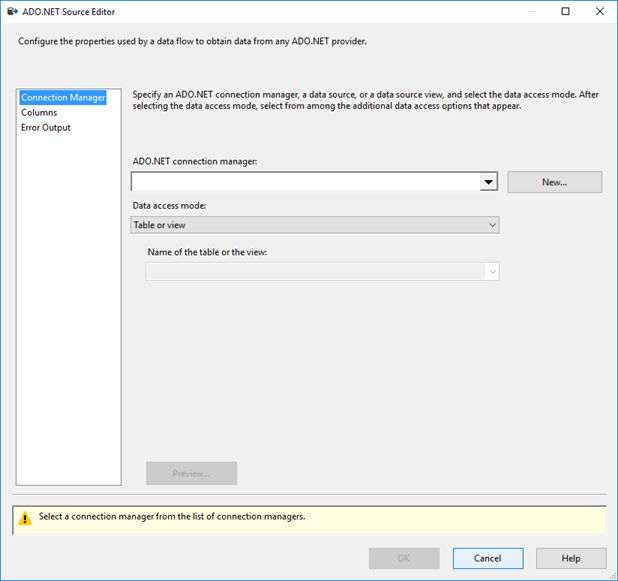
On the Connection Manager tab of the ADO.NET Source Editor, select the New button next to the ADO.NET connection manager list to open the Configure ADO.NET Connection Manager dialog box and create connection settings for the SQL Server database from which this tutorial loads data.

In the Configure ADO.NET Connection Manager dialog box, select the New button to open the Connection Manager dialog box and create a new data connection.
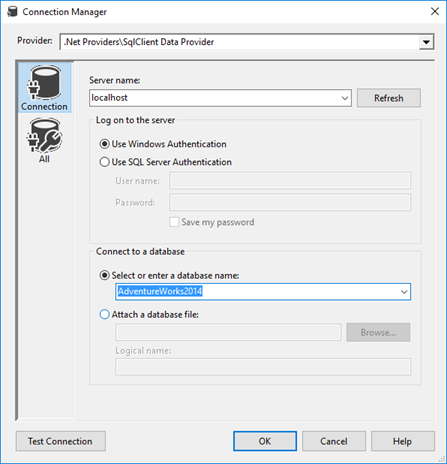
In the Connection Manager dialog box, do the following things.
For Provider, select the SqlClient Data Provider.
For Server name, enter the SQL Server name.
In the Log on to the server section, select or enter authentication information.
In the Connect to a database section, select the AdventureWorks sample database.
Select Test Connection.

In the dialog box that reports the results of the connection test, select OK to return to the Connection Manager dialog box.
In the Connection Manager dialog box, select OK to return to the Configure ADO.NET Connection Manager dialog box.
In the Configure ADO.NET Connection Manager dialog box, select OK to return to the ADO.NET Source Editor.
In the ADO.NET Source Editor, in the Name of the table or the view list, select the Sales.SalesOrderDetail table.

Select Preview to see the first 200 rows of data in the source table in the Preview Query Results dialog box.
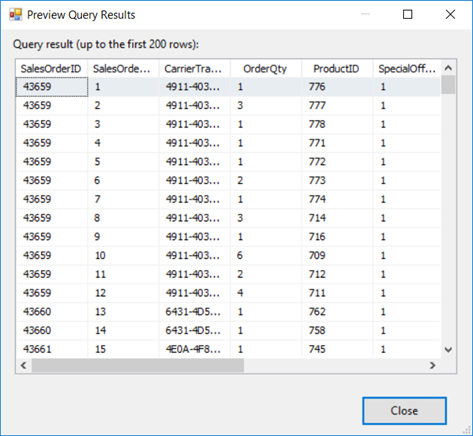
In the Preview Query Results dialog box, select Close to return to the ADO.NET Source Editor.
In the ADO.NET Source Editor, select OK to finish configuring the data source.
Connect the source adapter to the destination adapter
Select the source adapter on the design surface.
Select the blue arrow that extends from the source adapter and drag it to the destination editor until it snaps into place.

In a typical SSIS package, you use several other components from the SSIS Toolbox in between the source and the destination to restructure, transform, and cleanse your data as it passes through the SSIS data flow. To keep this example as simple as possible, we're connecting the source directly to the destination.
Configure the destination adapter
Double-click the destination adapter to open the ADO.NET Destination Editor.
On the Connection Manager tab of the ADO.NET Destination Editor, select the New button next to the Connection manager list to open the Configure ADO.NET Connection Manager dialog box and create connection settings for the database into which this tutorial loads data.
In the Configure ADO.NET Connection Manager dialog box, select the New button to open the Connection Manager dialog box and create a new data connection.
In the Connection Manager dialog box, do the following things.
For Provider, select the SqlClient Data Provider.
For Server name, enter the name of the SQL Server or of the SQL Database server.
In the Log on to the server section, select Use SQL Server authentication and enter authentication information.
In the Connect to a database section, select an existing database.
Select Test Connection.
In the dialog box that reports the results of the connection test, select OK to return to the Connection Manager dialog box.
In the Connection Manager dialog box, select OK to return to the Configure ADO.NET Connection Manager dialog box.
In the Configure ADO.NET Connection Manager dialog box, select OK to return to the ADO.NET Destination Editor.
In the ADO.NET Destination Editor, select New next to the Use a table or view list to open the Create Table dialog box to create a new destination table with a column list that matches the source table.
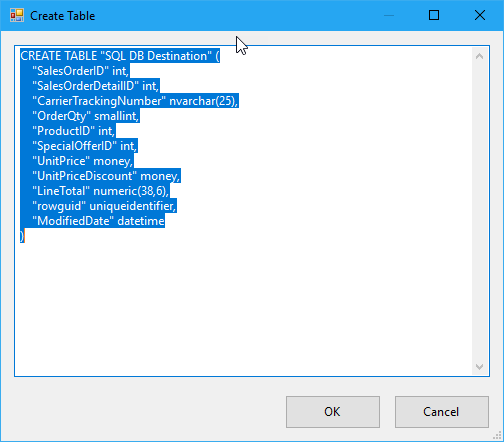
In the Create Table dialog box, do the following things.
Change the name of the destination table to SalesOrderDetail.
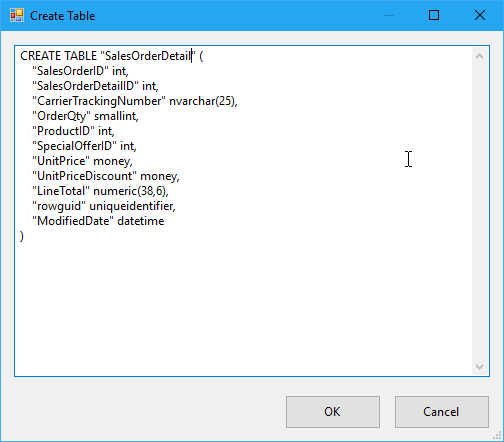
Select OK to create the table and return to the ADO.NET Destination Editor.
In the ADO.NET Destination Editor, select the Mappings tab to see how columns in the source are mapped to columns in the destination.
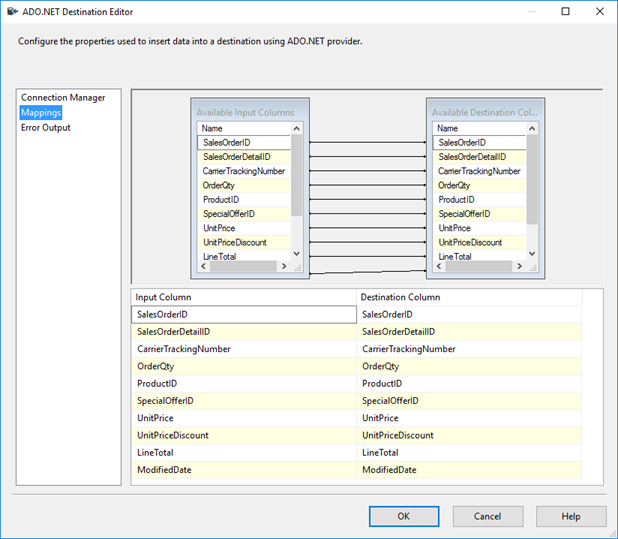
Select OK to finish configuring the destination.
Run the package to load the data
Run the package by selecting the Start button on the toolbar or by selecting one of the Run options on the Debug menu.
The following paragraphs describe what you see if you created the package with the second option described in this article, that is, with a data flow containing a source and destination.
As the package begins to run, you see yellow spinning wheels to indicate activity and the number of rows processed so far.

When the package has finished running, you see green check marks to indicate success and the total number of rows of data loaded from the source to the destination.

Congratulations, you've successfully used SQL Server Integration Services to load data into SQL Server or Azure SQL Database.
